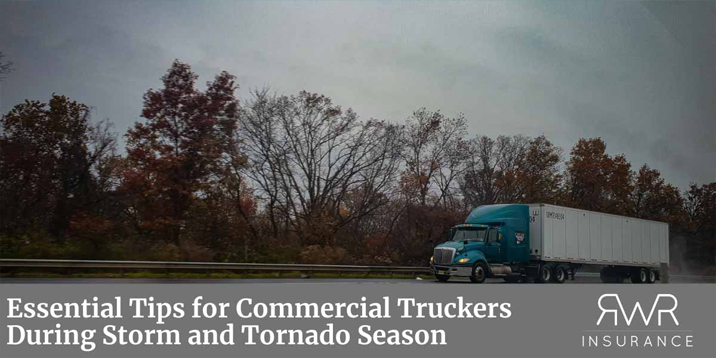As storm and tornado season approaches, commercial truckers must prepare themselves and their vehicles to stay safe while on the road. Severe weather, especially storms and tornadoes, can cause dangerous driving conditions, and navigating through such conditions requires careful planning, attention, and quick decision-making. For commercial truckers, the stakes are even higher as they often carry valuable cargo and drive long distances in unpredictable weather conditions. This blog provides essential tips for commercial truckers to help them stay safe during storm and tornado season, protect their cargo, and ensure they can keep their business running smoothly.
- Stay Informed with Weather Alerts
The first step in staying safe during storm and tornado season is to stay informed. Storms and tornadoes can form quickly, so it’s crucial to monitor weather reports regularly. Here are some ways you can stay updated:
- Use Weather Apps: Download reliable weather apps on your phone to receive real-time alerts about any upcoming storms, tornadoes, or severe weather in your area. Apps such as The Weather Channel, AccuWeather, and WeatherBug can provide live updates, radar maps, and weather warnings.
- Listen to NOAA Weather Radio: The National Oceanic and Atmospheric Administration (NOAA) broadcasts emergency weather alerts that can help you prepare for severe weather. Most commercial trucks come equipped with a weather radio, but if yours doesn’t, consider investing in a portable model.
- Utilize In-Cab Technology: Many modern trucks come with in-cab systems that provide weather alerts and live traffic updates. Make sure to familiarize yourself with these systems and use them to receive timely weather updates while on the road.
By staying informed, you can anticipate potential hazards and make informed decisions about whether to continue driving or seek shelter.
- Plan Your Route in Advance
Planning your route in advance is essential, particularly during storm and tornado season. Severe weather can impact road conditions, traffic patterns, and overall safety. Here’s how to make sure your route is safe:
- Check the Weather Forecast Along Your Route: Before hitting the road, check the weather forecast for your entire route. Many weather apps allow you to view forecasts for multiple locations, so you can plan accordingly. Be aware of any potential storms, tornadoes, or heavy rainfall in your path.
- Avoid Known Severe Weather Zones: If you know that a region is prone to severe weather or tornadoes, consider rerouting your journey to avoid those areas during peak storm times. Look for alternate highways or interstates that might be safer.
- Use Real-Time Traffic and Weather Services: Many trucker-specific navigation apps, such as Trucker Path or Truck Map, provide real-time updates on road conditions and weather hazards. Use these apps to help navigate around road closures, accidents, or inclement weather.
- Know Emergency Shelter Locations: Familiarize yourself with the locations of truck stops, rest areas, and shelters along your route where you can take refuge in case of severe weather. It’s also a good idea to know the nearest tornado shelters in the areas you’ll be passing through.
By planning your route with the weather in mind, you’ll be better prepared to avoid stormy or hazardous conditions.
- Monitor Your Speed and Driving Conditions
When driving during storm and tornado season, adjusting your speed to the conditions is essential for maintaining control of your vehicle. Here’s how to drive safely during severe weather:
- Slow Down in Rain or Fog: Heavy rain and fog can significantly reduce visibility and road traction. If you encounter these conditions, slow down to maintain better control of your vehicle and reduce the risk of hydroplaning. Make sure your truck’s lights are on to increase visibility.
- Increase Following Distance: In wet or slippery conditions, it’s important to increase your following distance. This gives you more time to react to any obstacles or sudden stops and helps prevent collisions. A good rule of thumb is to keep a following distance of at least 6 seconds in rainy or stormy weather.
- Avoid Sudden Maneuvers: Sudden steering or braking in wet conditions can cause a loss of control. Drive smoothly and avoid sudden maneuvers, particularly when turning or changing lanes.
- Watch for Flooded Areas: Flooding is a common result of heavy rain. Avoid driving through areas where the road is submerged, as you risk losing control or stalling your truck. If water covers the road, find an alternate route or pull over to wait until conditions improve.
- Stay Calm in High Winds: If high winds are a concern, reduce your speed and remain alert for signs of wind gusts that could cause your truck to sway. Wind gusts can be especially dangerous for large commercial trucks, so be sure to pay close attention to wind warnings and adjust your driving accordingly.
- Know When to Pull Over: If conditions become too dangerous to continue driving, such as during a severe storm, tornado warning, or visibility issues, pull over to a safe location, such as a truck stop or rest area, and wait for conditions to improve. It’s better to arrive late than to risk your safety.
- Know the Signs of an Approaching Tornado
Understanding the signs of an approaching tornado is critical to ensuring your safety. While tornadoes can form quickly and without much warning, there are some key indicators that you should look out for:
- Dark, Greenish Sky: A dark, greenish hue in the sky often indicates the presence of severe weather, including a tornado.
- Hail and Heavy Rain: Tornadoes are often preceded by hail and intense rainfall. If you encounter these conditions, take extra caution, as a tornado could be forming nearby.
- Large, Low-Hanging Clouds: Tornadoes often form from large, rotating cloud formations, which may appear as a funnel-shaped cloud in the sky. If you see these types of clouds, be prepared for the possibility of a tornado.
- Continuous, Roaring Sound: A continuous, loud roaring sound or a sound similar to a passing train can indicate an approaching tornado. If you hear this sound, take immediate action and seek shelter.
If you suspect a tornado is near, follow these steps:
- Seek Shelter Immediately: If you’re in a truck stop, rest area, or other facility, go inside and find a designated tornado shelter. If you’re on the road, stop your truck in a safe location and seek shelter in a nearby building or low-lying area (such as a ditch) away from trees or overpasses.
- Avoid Overpasses: Contrary to popular belief, overpasses are not safe shelters during a tornado. The wind can funnel underneath, intensifying the force of the storm and putting you at greater risk. Find a low-lying area away from overpasses.
- Stay in the Lowest Part of Your Vehicle: If you’re unable to find shelter in time, lie flat in the lowest part of your vehicle (preferably in the floorboards) and cover your head. Avoid staying in your truck if it’s a high-profile vehicle, as it may be overturned by strong winds.
- Prepare Your Truck for Severe Weather
Preparing your truck for storm and tornado season can help minimize potential damage and ensure your vehicle is equipped for the challenges of severe weather. Here’s what you should check:
- Check Your Tires: Make sure your tires are in good condition and properly inflated. Wet roads can increase the risk of hydroplaning, and worn tires can make it more difficult to maintain control.
- Inspect Your Brakes: Test your brakes to ensure they’re working properly. In stormy conditions, you need your brakes to respond effectively to avoid accidents.
- Ensure Proper Lighting: Make sure all lights (headlights, taillights, brake lights, and turn signals) are working properly. Good lighting is essential during rain, fog, or nighttime driving.
- Stock Up on Emergency Supplies: Have emergency supplies on hand in case you get stranded or need to take shelter during severe weather. Your emergency kit should include a flashlight, non-perishable food, water, a first-aid kit, a blanket, and a battery-powered weather radio.
- Ensure Windshield Wipers Are Functional: Good visibility is key when driving in rainy or stormy conditions, so make sure your windshield wipers are in top condition. Replace old wipers that may leave streaks or fail during heavy rain.
- Stay Calm and Focused
One of the most important tips for truckers during storm and tornado season is to stay calm and focused on the road. Severe weather can create stress, but panicking or overreacting can lead to poor decision-making. Take deep breaths, stay alert, and make decisions based on the information you have available.
- Practice Patience: Sometimes, the safest option is to pull over and wait out the storm. Trust your instincts and don’t rush to continue driving if conditions are unsafe.
- Keep Your Focus on the Road: During stormy weather, distractions can lead to accidents. Stay focused on the road, avoid using your phone, and keep both hands on the wheel at all times.
Storm and tornado seasons present unique challenges for commercial truckers, but with the right precautions, you can stay safe on the road. By staying informed about weather conditions, planning your route, monitoring driving conditions, and being prepared for severe weather, you can protect yourself, your cargo, and your truck. Remember, safety is the number one priority, so don’t hesitate to stop if conditions become too dangerous. By following these essential tips, you can navigate storm and tornado season with confidence and ensure that you and your business stay safe and secure.

